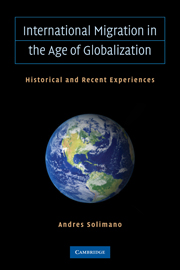Book contents
- Frontmatter
- Contents
- Acknowledgments
- 1 Introduction: Understanding the Trends, Themes, and Strata of International Migration
- 2 Why People Move or Stay Put: International Migration Is the Result of Compelling and Conflicting Factors
- 3 What Happens When International Migration Happens? The Dilemmas Posed by Migration
- 4 How Empires, Policy Regimes, and Economic Imperatives Influenced the Mobility of Capital and People in the 20th Century
- 5 Latin America: Where Volatile Economic Development, Political Crises, Poverty, and Remittance Income Is a Laboratory for Studying the Determinants of International Migration
- 6 Who Migrates and What They Offer: A Focus on People and Elites with Talent, Knowledge, and Entrepreneurial Skills
- 7 A Fair and Orderly International Migration Process Requires a Global Social Contract
- References
- Index
3 - What Happens When International Migration Happens? The Dilemmas Posed by Migration
Published online by Cambridge University Press: 05 June 2012
- Frontmatter
- Contents
- Acknowledgments
- 1 Introduction: Understanding the Trends, Themes, and Strata of International Migration
- 2 Why People Move or Stay Put: International Migration Is the Result of Compelling and Conflicting Factors
- 3 What Happens When International Migration Happens? The Dilemmas Posed by Migration
- 4 How Empires, Policy Regimes, and Economic Imperatives Influenced the Mobility of Capital and People in the 20th Century
- 5 Latin America: Where Volatile Economic Development, Political Crises, Poverty, and Remittance Income Is a Laboratory for Studying the Determinants of International Migration
- 6 Who Migrates and What They Offer: A Focus on People and Elites with Talent, Knowledge, and Entrepreneurial Skills
- 7 A Fair and Orderly International Migration Process Requires a Global Social Contract
- References
- Index
Summary
Chapter 2 examined why people migrate. But what happens in origin and destination countries when they do? In the United States, a larger voice calls for restricting immigration and certainly eliminating illegal migration. But perhaps a “silent” majority – business owners and the service industry, in particular – have the opposite desire. And what would happen to an economy if it did not have a pool of cheap labor, or, conversely, access to the creative, technological, and entrepreneurial talents of an intellectual elite that is not homegrown? On the other hand, what happens to origin countries when a labor or talent pool leaves? Of course, origin countries may see migration as a blessing if its labor supply can be absorbed only so far in their economies, but a “brain drain” may harm the prospects for an origin country to climb the developmental ladder.
Of course, a country may try to absorb labor and professionals by attracting foreign investment to create industry and jobs; theoretically, in countries with natural resources, investment would help them climb the developmental ladder. Similarly, the globalization process should be creating a more balanced playing field for all countries, where the movement of capital and labor should lead to a “convergence” of wage levels and rental rates of capital, thus, over time shrinking migration (and capital) flows. Obviously it has not. In fact, where wages are higher, people will be like moths to a flame.
Information
- Type
- Chapter
- Information
- International Migration in the Age of Crisis and GlobalizationHistorical and Recent Experiences, pp. 41 - 77Publisher: Cambridge University PressPrint publication year: 2010
